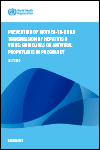Guidelines - Released in 2020
WHO estimates that in 2015, 257 million people were living with chronic hepatitis B virus (HBV) infection worldwide, and that 900 000 had died from HBV infection, mostly as a result of cirrhosis or hepatocellular carcinoma. Most HBV-associated deaths among adults are secondary to infections acquired at birth or in the first five years of life. In May 2016, the World Health Assembly endorsed the Global health sector strategy on viral hepatitis, which calls for the elimination of viral hepatitis as a public health threat by 2030 (defined as a 90% reduction in incidence of new infections and a 65% reduction in mortality). Elimination of HBV infection as a public health threat requires a reduction in the prevalence of hepatitis B surface antigen (HBsAg) to below 0.1% in children 5 years of age. This can be achieved through universal immunization of newborns against hepatitis B and other interventions to prevent mother-to-child transmission of HBV.
These guidelines provide evidence-based guidance on the use of peripartum antiviral prophylaxis in HBsAg-positive pregnant women for the prevention of mother-to-child transmission of HBV.
Downloads
Organizations
- World Health Organization (WHO)






